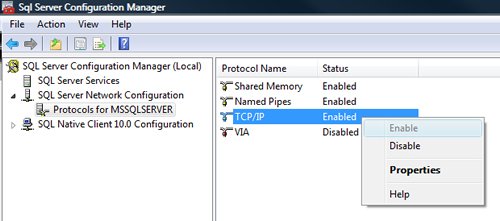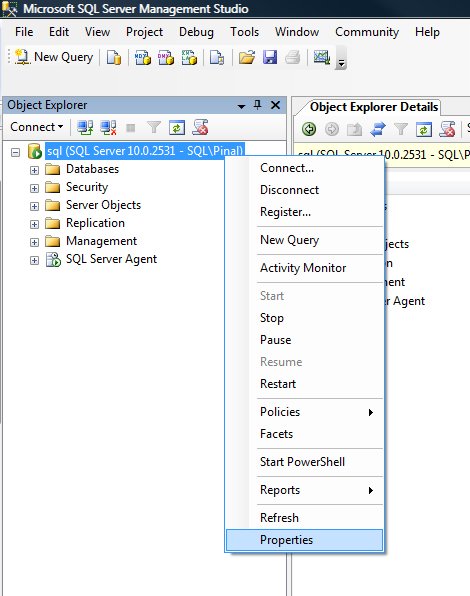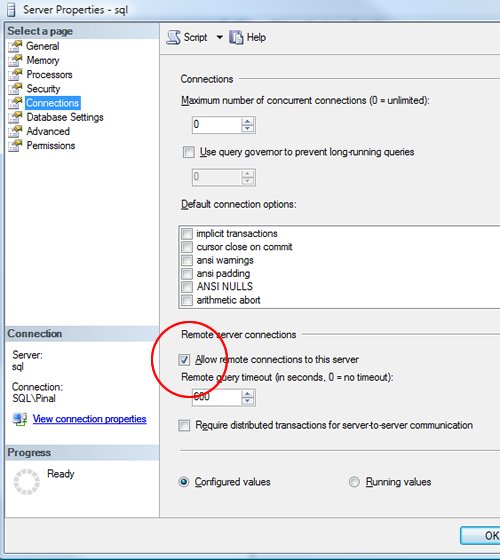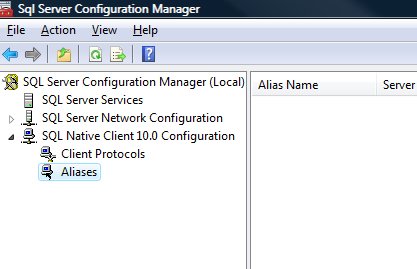Regular readers of my blog are aware of the fact that I have written about this subject umpteen times earlier, and every time I have spoken about a new issue related to it. Few days ago, I had redone my local home network. I have LAN setup with wireless router connected with my four computers, two mobile devices, one printer and one VOIP solution. I had also formatted my primary computer and clean installed SQL Server 2008 into it. Yesterday, incidentally, I was sitting in my yard trying to connect SQL Server located in home office and suddenly I stumbled upon the following error. Finding the solution was the most infuriating part as it consumed my precious 10 minutes.
Let us look at few of the common errors received:
An error has occurred while establishing a connection to the server.
(provider: Named Pipes Provider, error: 40 – Could not open a connection to SQL Server) (Microsoft SQL Server, Error: 5)
An error has occurred while establishing a connection to the server. When connecting to SQL Server 2005, this failure may be caused by the fact that under the default settings SQL Server does not allow remote connections. (provider: Named Pipes Provider, error: 40 – Could not open a connection to SQL Server) (Microsoft SQL Server, Error: 1326)
I eventually found the resolution to this error on this blog itself; so I was saved from hunting for the solution. I am sure there are a number of developers who had previously fixed this error while installing SQL Server 2008 or SQL Server 2005 but in due course forgot the right solution to this error. This is just a quick refresher. Make sure to bookmark this as you never know when you would need this solution.
Let us check into the steps to resolve this error.
1) SQL Server should be up and running.
Go to All Programs >> Microsoft SQL Server 2008 >> Configuration Tools >> SQL Server Configuration Manager >> SQL Server Services, and check if SQL Server service status is “Running”.
In addition, ensure that your remote server is in the same network. Run “sqlcmd -L” in your command prompt to ascertain if your server is included in your network list. You can even find tutorial for the same here SQL SERVER – Find All Servers From Local Network – Using sqlcmd – Detect Installed SQL Server on Network.
I have confronted numerous situations when these nerve-wracking errors crop up, and most of the time when I try to troubleshoot I notice that SQL Server services are neither running nor installed. If SQL Server is not installed as default instance SQL Server Browser should be running together with it; we will explore this further in Topic 5.

2) Enable TCP/IP in SQL Server Configuration
When two or more SQL Servers are connected across network they do all communication using TCP/IP. The default port of SQL Server installation is 1433. This port can be changed through SQL Server Configuration Manager. TCP/IP should be enabled for SQL Server to be connected.
Go to All Programs >> Microsoft SQL Server 2008 >> Configuration Tools >> SQL Server Configuration Manager >> Select TCP/IP

Right Click on TCP/IP >> Click on Enable

You must restart SQL Server Services for all the changes to take effect. Right click and go to menu properties to select location where default port of SQL Server can be changed.
3) Open Port in Windows Firewall
Windows Firewall is very efficacious in protecting the Operating system from all sorts of malicious attacks. By default, many of the ports and services are refrained from running by firewall. Time and again, SQL Server ports are not open in firewall as well. All the ports on which SQL Server is running should be added to exception and firewall should filter all the traffic from those ports. As described, by default SQL Server runs on port 1433, but if default port is changed then the new port should be added to exception. If SQL Server has named instance (another instance besides default instance) is installed, SQL Server browser should also be added to the exception, as described in Step 7.
Go to Control Panel >> Windows Firewall >> Change Settings >> Exceptions >> Add Port


Make the following entries in popup “Add a Port” and click OK.
Name : SQL
Port Number: 1433
Protocol: Select TCP


4) Enable Remote Connection
Enabling remote connection is another important, yet oft-neglected step that is frequently missed by database administrators while setting up SQL Server. If this feature is turned off SQL Server will function smoothly on local machine, but it will let another server connect to it remotely. By default this feature is ON in SQL Server 2008.
Right click on the server node and select Properties.

Go to Left Tab of Connections and check “Allow remote connections to this server”

5) Enable SQL Server Browser Service
If SQL Server is not installed as default instance but instead installed as named instance and also if there is no specific TCP/IP port configured, it will give rise to the error that is being discussed in this article. If SQL Server Browser service is enabled, it will allow the server to be connected through dynamic TCP/IP port. Enabling this service is a one-time process, as on enabling it once it will apply to all the instances installed on the same server.
Go to All Programs >> Microsoft SQL Server 2008 >> Configuration Tools >> SQL Server Configuration Manager >> SQL Server Browser

Right Click on SQL Server Browser >> Click on Enable
6) Create exception of sqlbrowser.exe in Firewall
As elucidated in Step 6, sqlbrowser service needs to be enabled for named instance. Windows Firewall may prevent sqlbrowser.exe to execute. So, it is imperative to add exception for the same in windows firewall.
Search for sqlbrowser.exe on your local drive where SQL Server is installed. Copy the path of the sqlbrowser.exe like C:\Program Files\Microsoft SQL Server\90\Shared\sqlbrowser.exe and create the exception of the file in Firewall, as delineated in Step 3.
7) Recreate Alias
It is getting quite common to create alias of SQL Server and use it in application. This will ensure that in future if any physical SQL Server has to be moved, it will not be required to change any code or connection string. You can simply create alias with the same name pointing to different SQL Server and it will start working instantaneously. I have observed that a couple of times due to internal error while recreating alias this error was fixed.
Go to All Programs >> Microsoft SQL Server 2008 >> Configuration Tools >> SQL Native Client 10.0 Configuration >> Aliases
Delete the alias that is giving problem and recreate it with identical parameters.

I have tried my best to include all the methods of fixing this error and if I have missed any, please leave a comment and I will be very glad to include them here. I have put in my effort to encompass this issue in one article that needs to be refereed when any connection error comes up.
Watch SQL in Sixty Seconds video to Resolve Connection Error:
[youtube=http://www.youtube.com/watch?v=1k00z82u4OI]
Reference : Pinal Dave (https://blog.sqlauthority.com)






658 Comments. Leave new
Hello Sir,
I installed one of your sql server dev edition software in starting it was going well but after some time it gives problem in connection with database error 53
please give some solution.
TITLE: Connect to Server
——————————
Cannot connect to 198.168.1.3.
——————————
ADDITIONAL INFORMATION:
A network-related or instance-specific error occurred while establishing a connection to SQL Server. The server was not found or was not accessible. Verify that the instance name is correct and that SQL Server is configured to allow remote connections. (provider: Named Pipes Provider, error: 40 – Could not open a connection to SQL Server) (Microsoft SQL Server, Error: 53)
For help, click: https://www.microsoft.com/en-us/?ProdName=Microsoft%20SQL%20Server&EvtSrc=MSSQLServer&EvtID=53
——————————
The network path was not found
——————————
BUTTONS:
OK
——————————
Thankyou,
kind regards
this error message only from production.. while connecting from local it is working fine !!!
Thank you so much for the help!!!
Thank you so much for the help.This blog is really useful to me.
Not quite the same error, but nzchris’ answer on this post https://stackoverflow.com/questions/27267658/no-process-is-on-the-other-end-of-the-pipe-sql-server-2012 should probably be included in your list.
(thanks for all the other pointers btw – still useful)
Thanks! Option 2 (enabling TCP/IP) fixed this for me. Very helpful blog, as always.
My computer is the client pc and I have only SSMS installed. I can connect other database server except one (say X server). But interestingly, X server can be connected from other computer too. I checked the client protocols in my Sql Server Configuration Manager. All three – shared memory, TCP/IP and Named Pipes are enabled. Please suggest what else should I do?
Hello Sir,
I installed one of your sql server dev edition software in starting it was going well but after some time it gives problem in connection with database error 53
please give some solution.
TITLE: Connect to Server
——————————
Cannot connect to 198.168.1.3.
——————————
ADDITIONAL INFORMATION:
A network-related or instance-specific error occurred while establishing a connection to SQL Server. The server was not found or was not accessible. Verify that the instance name is correct and that SQL Server is configured to allow remote connections. (provider: Named Pipes Provider, error: 40 – Could not open a connection to SQL Server) (Microsoft SQL Server, Error: 53)
Thanks, this is neat, clean and solves the problem. Great job.
Thanks Raja.
This is great, thanks a lot.
Item 5 save me 5) Enable SQL Server Browser Service
Thanks Pinal
Thanks Thiago
I added TCP port 1433 with below procedure and it worked :)
Go to SQL Server configuration manager > SQL Server network configuration > Protocols for IMPACT360 (name may be different).
TCP/IP > IP address > IP All > TCP Port = 1433
Thanks dear for the awesome article :)
The Named Pipes Provider: Could not open a connection to SQL Server [5] is often associated with permissions on the windows firewal or better than the server that contains the database and when accessing the base outside the computer will not be allowed to connect . So, go to firewal in inbound and add in the program permission area the SQL SERVER.
I am really grateful, it works. Thanks a lot sir . I have you to thank
I love you! May you live a long and prosperous life
Hi Pinal,
I am trying to upgrade SQL 2008 R2 express to sql 2016 express 64 bit and getting same error in installation. I tried above all solution but it didn’t work. Can you suggest more on that
Finally got it working! Thank you very much for this article! Great job!
Thanks a lot. It worked for me as well. Very helpful video.
Awesome, fixed my issue in 5 minutes after about an hour of floundering around!
You are welcome.